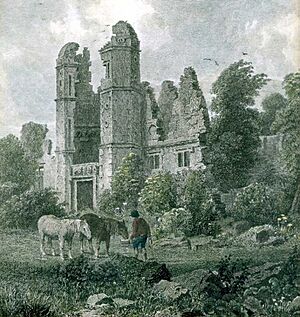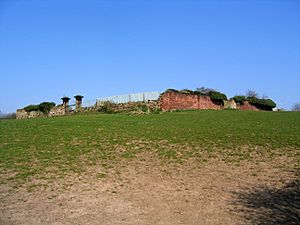Rocksavage facts for kids
Rocksavage was once a grand old house, now in ruins, located in Clifton, which is part of Runcorn, England. It was built a long time ago, between 1565 and 1568, for a man named Sir John Savage. This house was one of the most amazing and biggest homes in Cheshire during the Elizabethan era. In 1674, it was the second largest house in the whole county. Even King James I visited Rocksavage in 1617!
The house was left empty in the early 1700s when it became owned by the Cholmondeley family. By 1782, it was already a ruin. Rocksavage was built from sandstone and had a square shape with a central courtyard. Two round towers stood on either side of the main entrance. Today, only small parts of its garden and orchard walls are still standing. These walls are considered important historical structures.
Contents
History of Rocksavage
The Savage Family and Building the House
The Savage family were important landowners in Cheshire starting in the late 1370s. They gained land in Clifton when John Savage married Margaret Danyers. Sir John Savage, who built Rocksavage, was a very important person. He was a Member of Parliament for Cheshire and even the Mayor of Chester.
Rocksavage was built for him on a hillside that looked over the River Weaver. Construction started around 1565 and finished in 1568. It quickly became one of the most impressive "prodigy houses" in Cheshire. These were huge, fancy houses built to show off wealth and power. Records from 1674 show Rocksavage had fifty fireplaces, making it the second largest house in the county. Only Cholmondeley House was bigger. People in the early 1600s described it as a "magnificent" building. An older family home, Clifton Hall, was kept nearby and used for farm buildings.
Royal Visits and Challenges
King James I and his group had dinner at Rocksavage on August 21, 1617. He was on his way to other important places like Vale Royal Abbey and Chester.
Later, during the English Civil War, the owner, John Savage, supported the King. Because of this, soldiers who supported Parliament attacked Rocksavage. They damaged the house, destroying the roof and parts of the walls.
In 1682, the Duke of Monmouth also stayed at Rocksavage. He was visiting Cheshire to see who would support him against King Charles II.
The House is Abandoned
In the early 1700s, the Rocksavage estate passed to the Earl of Barrymore through marriage. Some new buildings were constructed higher up the hill. These might have been meant to replace Rocksavage or to be service buildings for it.
However, just a few years later, Rocksavage was left empty. The Earl of Barrymore's daughter married into the Cholmondeley family. Their main family home became Cholmondeley House. Rocksavage was no longer needed, so it quickly fell apart. By 1782, it was already a ruin.
Today, the Marquesses of Cholmondeley use the special title Earl of Rocksavage for their oldest son, who will inherit the main title.
What Rocksavage Looked Like
The Elizabethan mansion was built in a square shape, like a quadrangle, around a central courtyard. It was made of local red sandstone. The main entrance had a gateway with two tall, round towers on either side. These towers had domed tops and a wall with battlements connecting them. An old drawing from around 1818 shows these towers clearly.
Brereton Hall, another house built about twenty years later, was designed to look like Rocksavage. It even copied the two round towers. This gives us a good idea of what Rocksavage might have looked like when it was new.
The last big piece of the house fell down around 1980. Now, only the gateposts for the orchard and small parts of the garden and orchard walls are left. You can find them near the Weaver Viaduct over the M56 in Runcorn. These remaining pieces are protected as important historical structures.
The 18th-century Clifton Hall was originally a U-shaped brick building. One part of the "U" has been removed, and the rest is now surrounded by farm buildings.
Images for kids





